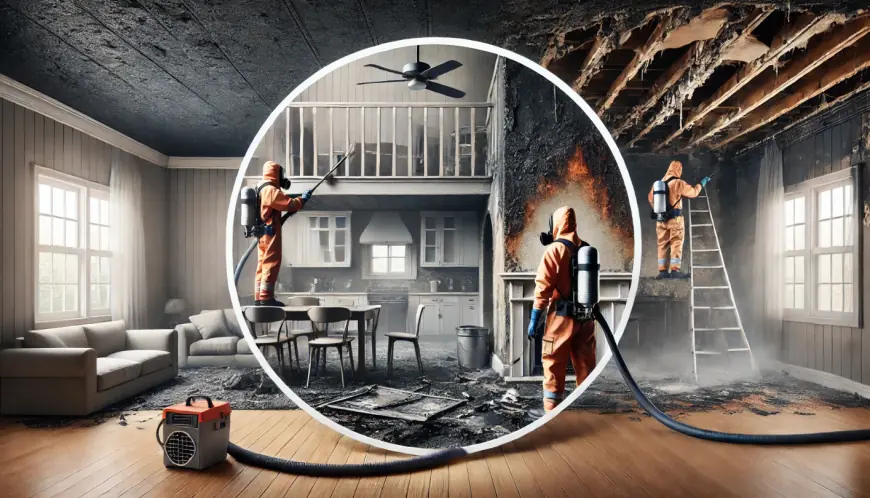What Are the Best Methods for Effective Smoke Damage Restoration After a Fire?
The aftermath of a fire can be devastating, not just because of the visible destruction but also due to the latent effects of smoke damage.

The aftermath of a fire can be devastating, not just because of the visible destruction but also due to the latent effects of smoke damage. Smoke infiltrates walls, furniture, and ventilation systems, leaving behind odors and toxins that pose significant health risks. Many homeowners underestimate the challenges of proper smoke damage restoration, often leading to long-term damage and potential respiratory issues.
Why Ineffective Smoke Restoration Can Have Dire Consequences
If you’re dealing with smoke damage, knowing the right restoration methods is essential to ensuring a safe and clean environment for your home or business. The right fire restoration contractor will guide you through the best techniques for effective smoke damage restoration while eliminating the risks of improper cleanup. Employing the right expert is essential, without which you are at severe risk in diverse aspects. Failing to properly address smoke damage can result in serious issues, including:
-
Health Risks: Residual smoke and soot contain toxic chemicals and fine particles that can cause respiratory problems, eye irritation, and skin allergies.
-
Residual Odors: If not thoroughly removed, smoke odors can persist for months, affecting indoor air quality and comfort.
-
Structural Damage: Soot and smoke residues are acidic and can gradually degrade surfaces, furniture, and even electronics.
-
Mold and Mildew Growth: The moisture introduced during firefighting efforts, combined with uncleaned smoke residue, creates a breeding ground for mold.
How Smoke Damage Affects Your Home and Health
Smoke damage is more than just an unpleasant smell—it can impact nearly every surface and material in your home. Here’s how:
-
Walls and Ceilings: Smoke seeps into porous materials, leading to stains and permanent discoloration.
-
Furniture and Fabrics: Upholstery absorbs smoke particles, which can be difficult to remove without professional treatment.
-
HVAC Systems: If not properly cleaned, your ventilation system can circulate smoke particles, continuously contaminating indoor air.
-
Health Concerns: Prolonged exposure to smoke residue can cause headaches, dizziness, and aggravate conditions like asthma and bronchitis.
Best Methods for Effective Smoke Damage Recovery
Here is a quick guide to dealing with smoke damage. We aim to provide you with information that can help you act promptly.
Immediate Ventilation and Air Filtration
Open windows and doors for fresh air; use industrial-grade HEPA air purifiers to enhance air quality by capturing smoke particles.
Soot and Residue Removal
Vacuum loose soot with a HEPA vacuum to avoid spreading; regular vacuums can worsen contamination.
Deep Cleaning of Surfaces
Clean non-porous surfaces with warm water, dish soap, and vinegar; for painted walls, use a trisodium phosphate (TSP) solution to break down smoke residue without damaging the paint.
Odor Elimination Techniques
Use activated charcoal in bowls around the house, sprinkle baking soda on carpets overnight before vacuuming, or employ professional ozone generators to remove stubborn smoke odors.
Professional Cleaning for Soft Materials
Deep clean fabrics, upholstery, and carpets using professional dry-cleaning or steam cleaning methods to effectively remove smoke particles without causing damage.
HVAC System Inspection and Cleaning
Conduct thorough duct cleaning and filter replacement to eliminate infiltrated smoke particles from HVAC systems.
Repainting and Sealing Surfaces
If odors persist post-cleaning, repaint using an oil-based primer to seal in any remaining smells before applying new paint.
Advantages of Hiring Professionals for Smoke Damage Restoration
While DIY methods might be helpful for minor smoke damage at times, severe cases often require the right professional intervention.
-
Advanced Equipment: Professionals use industrial-grade air scrubbers, ozone machines, and HEPA vacuums for thorough cleaning.
-
Comprehensive Soot and Odor Removal: Experts apply specialized cleaning agents and deodorization techniques that are more effective than household solutions.
-
Time and Cost Efficiency: Professional restoration prevents long-term damage, reducing future repair costs.
-
Expertise in Insurance Claims: Restoration companies can assist with documentation and insurance claims, easing the financial burden of recovery.
Conclusion
Research on PubMed says that soot and smoke damage after fires have been the leading reason for patients to develop respiratory diseases like COPD. This means that the problem of smoke damage is visibly serious. So we recommend taking quick action against it. If you need immediate assistance, searching for smoke and soot cleanup near me can connect you with certified professionals in your area. Look for companies with positive reviews, proper certifications, and 24/7 emergency services to ensure a swift and effective cleanup process. Smoke damage restoration is a crucial step in reclaiming your home or business after a fire. By following the right restoration techniques—or hiring experienced professionals—you can ensure a safe and clean environment for yourself and your family.

 markbrown9839
markbrown9839 










